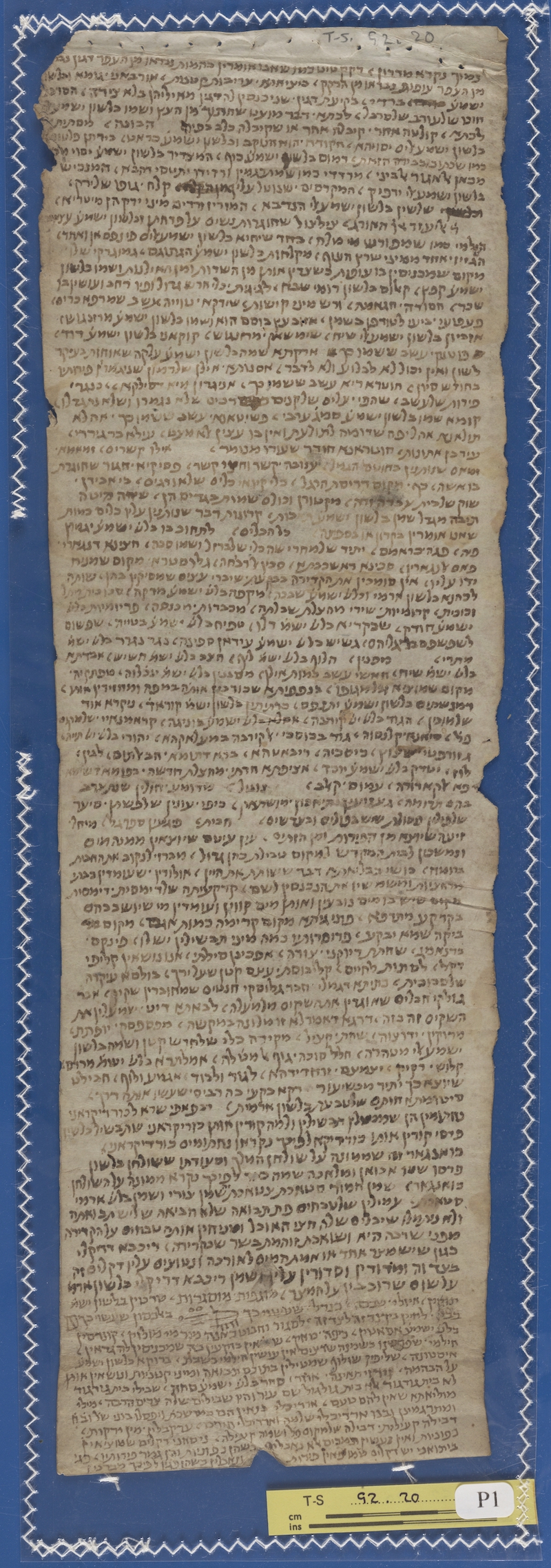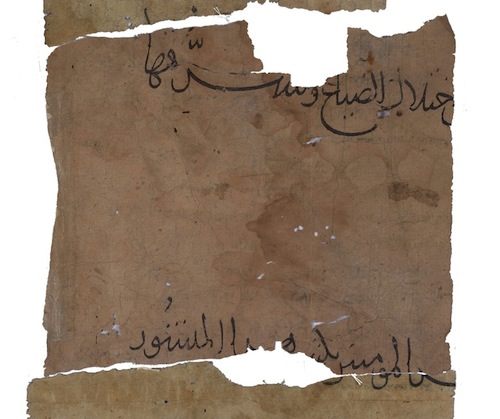The She’iltot, recycling manuscripts and Efrayim b. Shemarya, T-S F13.1 and more
By Roni Shweka, Marina Rustow and Judith Olszowy-Schlanger
Reconstructing a book from fragments preserved in the Genizah is like trying to complete a puzzle where most of the pieces are missing. Recently, Roni Shweka pieced together six fragments of an eleventh-century rotulus of the She’iltot located in four different Genizah collections. The resulting manuscript proved of great interest in several different ways.
A rotulus is a vertical scroll with the text written parallel to the short side. Judith Olszowy-Schlanger, who is currently studying rotuli from the Genizah, calls it ‘the third form of the Hebrew book’, after the megilla (the horizontal scroll, in which the text runs parallel to the long side) and the codex (the bound book as we know it). The rotulus used to be thought of as an early and transitional book-form between the megilla (the medium preferred by Jews in antiquity) and the codex (which Jews adopted following the Islamic conquests; Christians had started using it several centuries earlier). Together with Gideon Bohak, Olszowy-Schlanger has found about three-hundred fragments of rotuli in the Genizah, many of them dating to as late as the eleventh century. The form was especially popular for copying texts for personal use, such as study copies of the Talmud or of responsa, or for liturgical poetry and hafṭarot. Because the works were user-produced and informal, they were usually written on less expensive material, often on the backs of other, disused texts.

A section from a typical Genizah rotulus, containing responsa (T-S G2.20)
The rotulus that Shweka reconstructed contains a passage from the begining of the She’iltot, a mid-eighth-century Iraqi collection of public sermons on halakhic topics corresponding to the weekly Torah reading. The She’iltot, attributed to Aḥa of Shabḥa, was the first independent halakhic work composed after the redaction of the Babylonian Talmud.
We know today of about ten complete manuscripts and more than one hundred Genizah fragments containing the She’iltot. Most can be grouped into two major textual families. But the text of the She’iltot that Shweka reconstructed does not correspond to any known manuscript witness. Instead, it either represents an otherwise unknown version of the book, or was altered by the person who copied it, perhaps to fit the specific context in which he wanted to make use of the sermonic material it contained.
And as it happens, we know who the copyist was. By means of paleographic analysis, Olszowy-Schlanger identified him as Efrayim ben Shemarya, head of the Palestinian Rabbanite congregation in Fustat between 1016 and 1055 (it is also possible that everything attributed to him was written by a scribe working closely with him). Elinoar Bareket, who reconstructed Efrayim ben Shemarya’s ‘archive’, had identified and joined the bottom two fragments in an article on his literary works (HUCA 75 [2004]: 25–50). Shweka found those and four additional fragments in the course of his research into the transmission of the She’iltot; we have since found additional fragments of literary works in the same hand.
The reconstructed rotulus is nearly one metre long, but it is still incomplete. Efrayim (or his scribe) wrote it on the back of a Fatimid decree, a genre of document that could run as long as ten metres. Marina Rustow is currently searching for Arabic government petitions, decrees, and internal bureaucratic directives in the Genizah collections and undertaking a project on them in collaboration with Geoffrey Khan. There are several hundred such documents from the Genizah, most of them fragments, and many reused for texts in Hebrew script.
In searching for paper of the right dimensions to produce a rotulus, a medieval scribe had two options: to glue together shorter documents of the proper width (e.g., the Fatimid petitions Bodl. MS Heb. 18.23 and ENA 3974.3, which contain a hafṭara rotulus on verso; see Rustow in BSOAS 73 [2010]); or to take a much larger rotulus and trim it down to size, for instance by cutting it in half vertically. This scribe chose the latter option.
Decrees became available as writing material because the chancery (dīwān al-inshāʾ) in Cairo sent them to provincial governors or local communities, and after they had been posted publicly, read aloud or otherwise made to serve their purpose, they were often recycled as scrap paper. Frédéric Bauden has demonstrated a similar phenomenon with a pair of Mamluk decrees that he found embedded in an autograph notebook of the historian al-Maqrīzī (d. 1442) now at the University of Liège, and hypothesised that they were deacquisitioned after a raid on the Mamluk palace. Al-Maqrīzī himself mentions that after this attempted coup, documents from palace archives were sold by weight on the open market as scrap paper. (See Bauden, ‘Maqriziana I: Discovery of an Autograph Manuscript of Al-Maqrīzī: Towards a Better Understanding of His Working Method. Description: Section 1’, Mamlūk Studies Review 7 [2003]: 21–68, and idem, ‘The Recovery of Mamluk Chancery Documents in an Unsuspected Place’, in The Mamluks in Egyptian and Syrian Politics and Society, ed. Michael Winter and Amalia Levanoni [Brill, 2004], 59–78.)
Decrees were particularly well adapted to reuse, for two reasons: they usually contained writing on only one side, leaving the verso blank; and the calligraphers of the dīwān al-inshāʾ used very wide line-spacing—the medieval equivalent of conspicuous consumption.

Part of the Fatimid decree on the other side, showing the enormous amount of space left between the lines of text
Many recycled decrees have survived in the Genizah, almost all of them as fragments. Not all were reused as rotuli, however: they could be folded twice to yield four separate writing spaces on each side, as with T-S Misc.36.174, a fragment of a Fatimid decree re-employed for a Hebrew poem commemorating the Seljuk defeat at Cairo in 469/1076 (published by Julius H. Greenstone, American Journal of Semitic Languages and Literatures 22 [1906]); or folded in half to yield a bifolium, as with T-S F8.64, a fragment of a decree reused for part of the Talmud tractate Bava Meṣiʿa (see Shamma Friedman, Alei Sefer 9 [1981]).
But whether they were reused as rotuli or folded to form bifolia, all the fragments of Fatimid decrees share one feature: their Arabic texts are nearly impossible to piece together, due to a simple matter of line density, since they typically contain only one or two lines of Arabic. Importantly, their reuse for denser Hebrew-script texts thus provides a new way to piece them together with certainty—and thus to reconstruct Arabic decrees, which have otherwise survived only in very tiny numbers.
Six of the fragments that Shweka identified were from the left half of the decree, and clearly show the ends of lines. The seventh, Mosseri VI.117.2, was from the right half, and thus offers a precious piece of information: the width of the original (42 cm). Its length still cannot be determined; the reconstructed fragment is nearly one metre long, but Fatimid decrees usually ran between four and ten metres long. Shweka has further identified additional decree fragments with versos in Efrayim ben Shemarya’s hand, one of them (identified together with Ronny Vollandt) containing an abridged version of Se‘adya’s Tafsīr.
The three of us began this work in the context of the European Seminar on Advanced Jewish Studies, the working group on Material Aspects of Genizah Text convened at the University of Oxford during the first half of 2011. We are more convinced than ever of the utility of teamwork in Geniza research, and hope to continue working together and with other colleagues to explore the library, working methods, and secondhand stationery supplies of the scribe currently known to us as Efrayim ben Shemarya.
The rotulus of She’iltot, the separate pieces digitally reunited

The Fatimid decree on the back of the manuscript
Image sources and credit
From top to bottom, the composite image is composed of:
T-S F13.1 (P1); ENA 4045.2; T-S F13.1(P2); Rylands B 5446; T-S F13.20 (on the right, on the She’iltot side of the image) and ENA 3751.5 (on the left).
The image of Rylands B 5446 is reproduced by courtesy of the University Librarian and Director, The John Rylands University Library, The University of Manchester.
The images of ENA 4045.2 and ENA 3751.5 are courtesy of the Library of The Jewish Theological Seminary.
The authors would like to thank Arbel Buchuk, graphic designer for the Friedberg Genizah Project, who created the composite images.
Bibliography
Elinoar Bareket, The Exegetical Writing of Ephraim Ben Shemaria, Head of the Community in Fustat, Egypt, during the First Half of the Eleventh Century, HUCA 75 (Hebrew; 2004), pp. 25–50.
Frédéric Bauden, ‘Maqriziana I: Discovery of an Autograph Manuscript of Al-Maqrīzī: Towards a Better Understanding of His Working Method. Description: Section 1’, Mamlūk Studies Review 7 (2003), pp. 21–68.
—, ‘The Recovery of Mamluk Chancery Documents in an Unsuspected Place’, in The Mamluks in Egyptian and Syrian Politics and Society, Michael Winter and Amalia Levanoni (eds) (Brill, 2004), pp. 59–78.
Shamma Friedman, ‘Early Manuscripts to Tractate Bava Meṣiʿa’, Alei Sefer 9 (Hebrew; 1981), pp. 5–55.
Julius H. Greenstone, ‘The Turkoman Defeat At Cairo, By Solomon ben Joseph Ha-Kohen’, American Journal of Semitic Languages and Literatures 22 (1906), pp. 144–175.
Marina Rustow, A Petition to a Woman at the Fatimid Court (413–414 A.H./1022–23 C.E.), BSOAS 73 (2010), pp.1–27.
Cite this article
(2011). The She’iltot, recycling manuscripts and Efrayim b. Shemarya, T-S F13.1 and more. [Genizah Research Unit, Fragment of the Month, October 2011]. https://doi.org/10.17863/CAM.58101
If you enjoyed this Fragment of the Month, you can find others here.
Contact us: genizah@lib.cam.ac.uk
The zoomable images are produced using Cloud Zoom, a jQueryimage zoom plugin:
Cloud Zoom, Copyright (c) 2010, R Cecco, www.professorcloud.com
Licensed under the MIT License

